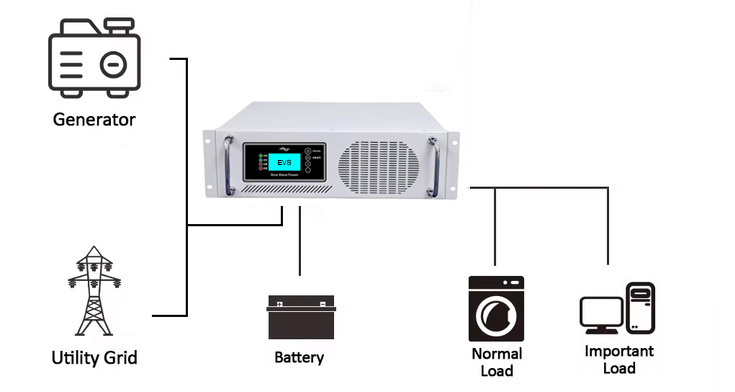Working principle of electric UPS
The electric UPS uninterruptible power supply, together with the power DC operation power supply system, forms a dedicated uninterruptible power supply for power plants and substations, supplying power to microcomputers, communications, carriers, emergency lighting, and other equipment that cannot be powered off. Taking power from existing DC operating power sources in power plants or substations does not require a separate battery pack like conventional UPS, thus avoiding redundant investment in batteries, reducing system maintenance, and lowering operating costs.
Electric UPS working principle
The working principle and output characteristics of power UPS are exactly the same as traditional UPS, but due to its connection to a DC operating power system, its DC input characteristics must meet the specific requirements of the power system. Power UPS is designed for the power industry such as power plants and substations. In power plants and power systems, core equipment such as DCS (distributed control system), monitoring systems, automation instruments, dispatch communication systems, and microcomputer systems have very high requirements for power supply quality and reliability, requiring dedicated UPS power supply. The vast majority of these loads are single-phase loads.
The power UPS system generally consists of three parts: the power UPS host, the bypass voltage regulator cabinet, and the output feeder cabinet (three in one can also be used for low power).
1. Power UPS main cabinet: input/output isolation transformer, rectifier, inverter, static bypass switch, bypass switch, check diode;
2. Bypass isolation voltage regulator cabinet: bypass isolation transformer, bypass voltage regulator, manual/bypass maintenance switch;
3. Feeder cabinet: circuit distribution unit, monitoring instruments, control switches, and signal indicators, etc;

Electric UPS Types of power sources for power plant systems:
(1) DC operation power supply: The DC power operation system, also known as the DC screen, provides power for controlling loads, power loads, and DC emergency lighting loads. It is the foundation of power plant system control and protection;
(2) Hydrogen production system power supply;
(3) Secondary acid electrolysis power supply;
(4) Power UPS power supply: Power UPS power supply provides reliable backup power guarantee for core equipment such as DCS (distributed control system), monitoring system, automation instrument, dispatch communication system, microcomputer system, etc. in the power system;
(5) Excitation power supply;
(6) Communication power supply;
(7) High voltage variable frequency power supply;
(8) High voltage desulfurization power supply,
Electric UPS Substation:
(1) DC operating power supply
(2) Communication power supply
(3) Inverter power supply
(4) Power UPS power supply
(5) Combination power supply
(6) Monitoring power supply
The dedicated power supply for UPS adopts a 1+1 redundant power supply system, which is designed for the application load and environment of the power system. It is an industrial grade AC protection power supply manufactured using advanced technology, which can fully meet the requirements of power supply reliability for loads such as DCS systems.
Advantages of the plan:
1) A professional UPS tailored for the power industry, suitable for the harsh power grid environment within the industry. It not only meets the load requirements of the power industry, but also eliminates the need for users to worry about three-phase imbalances in the load.
2) The 1+1 redundant parallel working mode adds another safety lock to the already reliable power supply system, meeting the extreme needs of power industry users for high reliability indicators of UPS.
3) By fully utilizing the 220V/110V high-capacity battery pack in the power industry, the backup time of UPS can be maximized, and the installation space and initial investment of the battery pack can be saved.
4) Optional bypass isolation transformer can achieve complete isolation between input and output, and ensure that the zero ground voltage of the output is less than 1V.
5) Rich dry contact monitoring signals can be incorporated into the power plant's own DCS monitoring system; Report any issues promptly to facilitate real-time monitoring of UPS by on duty personnel